AMD Threadripper 1920X and 1950X CPU Details: 12/16 Cores, 4 GHz Turbo, $799 and $999
by Ian Cutress on July 13, 2017 9:00 AM EST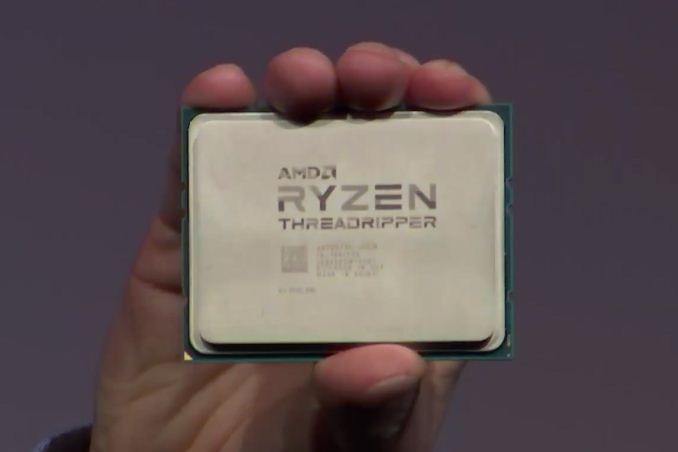
Last night out of the blue, we received an email from AMD, sharing some of the specifications for the forthcoming Ryzen Threadripper CPUs to be announced today. Up until this point, we knew a few things – Threadripper would consist of two Zeppelin dies featuring AMD’s latest Zen core and microarchitecture, and would essentially double up on the HEDT Ryzen launch. Double dies means double pretty much everything: Threadripper would support up to 16 cores, up to 32 MB of L3 cache, quad-channel memory support, and would require a new socket/motherboard platform called X399, sporting a massive socket with 4094-pins (and also marking an LGA socket for AMD). By virtue of being sixteen cores, AMD is seemingly carving a new consumer category above HEDT/High-End Desktop, which we’ve coined the ‘Super High-End Desktop’, or SHED for short.
Today’s announcements, accompanied by a video from the CEO of AMD Dr. Lisa Su, shed some light on the new SHED processors: namely clock speeds and pricing, and a reaffirmed commitment to launching the new CPUs in August.
| AMD Ryzen CPUs | |||||
| Threadripper 1950X |
Threadripper 1920X |
Ryzen 7 1800X |
|||
| Socket | TR4 (LGA) 4094-pin |
AM4 (PGA) 1331-pin |
|||
| Cores/Threads | 16 / 32 | 12 / 24 | 8 / 16 | ||
| Base Frequency | 3.4 GHz | 3.5 GHz | 3.6 GHz | ||
| Turbo Frequency | 4.0 GHz | 4.0 GHz | 4.0 GHz | ||
| XFR | ? (+100?) | ? (+100?) | +100 MHz | ||
| L3 Cache | 32 MB | 32 MB ? | 16 MB | ||
| TDP | 180W* | 180W* | 95 W | ||
| PCIe 3.0 Lanes | 60 + 4 | 60 + 4 | 16 + 4 + 4 | ||
| DRAM Frequency | 1DPC | ? | ? | DDR4-2666 | |
| 2DPC | ? | ? | DDR4-2400 | ||
| Chipset Support | X399 | X399 | X370 B350 A320 |
||
| Price (List) | $999 | $799 | $499 | ||
| Price (Retail) | TBD | TBD | $419 | ||
As you can see from the table, there are lots of question marks. We fired off a series of questions to AMD to fill in the blanks, so we can understand this product a bit better, but we were told to wait until closer to launch day. The only answer we could get was the styling on the naming. These are ‘Threadripper’ processors (rather than ThreadRipper), and are part of the Ryzen family, and the official SKU names are ‘Ryzen Threadripper 1950X’ and ‘Ryzen Threadripper 1920X’. We are likely to shorten these to ‘TR 1950X’ and ‘TR 1920X’ for expediency.
*180W was confirmed after this article was originally posted.
The AMD Ryzen Threadripper 1950X
From what we do know, 16 Zen cores at $999 is about the ballpark price we were expecting. With the clock speeds of 3.4 GHz base and 4 GHz Turbo, this is essentially two Ryzen 7 1800X dies at $499 each stuck together, creating the $999 price (obviously it’s more complicated than this). Given the frequencies and the performance of these dies, the TDP is likely in the 180W range; seeing as how the Ryzen 7 1800X was a 95W CPU with slightly higher frequencies. The 1950X runs at 4.0 GHz turbo and also has access to AMD’s XFR – which will boost the processor when temperature and power allows – in jumps of +25 MHz: AMD would not comment on the maximum frequency boost of XFR, though given our experiences of the Ryzen silicon and previous Ryzen processor specifications, this is likely to be +100 MHz. We were not told if the CPUs would come with a bundled CPU cooler, although if our 180W prediction is in the right area, then substantial cooling would be needed. We expect AMD to use the same Indium-Tin solder as the Ryzen CPUs, although we were unable to get confirmation at this at this time.
| Comparison: Threadripper 1950X vs Core i9-7980XE / Gold 6150 | |||
| AMD Threadripper 1950X |
Features | Intel Core i9-7980XE |
Intel Xeon Gold 6150 |
| 16 / 32 | Cores/Threads | 18 / 36 | 18 / 36 |
| 3.4 / 4.0 GHz | Base/Turbo | ? | 2.7 / 3.7 GHz |
| 60 | PCIe 3.0 Lanes | 44 | 44 |
| 512 KB/core | L2 Cache | 1 MB/core | 1 MB/core |
| 32 MB | L3 Cache | 24.75 MB | 24.75 MB |
| 180W* | TDP | ? (165W?) | 165W |
| $999 | Price (List) | $1999 | $3358 |
Intel has already announced that they will be launching the 18-core Intel Core i9-7980XE processor later this year for $1999, although final specifications have yet to be announced. Given the launch this week of Intel’s Skylake-SP Xeon processors, there is one CPU in that line-up that would fit the bill for an i9-7980XE candidate: the Xeon Gold 6150, running at a 2.7 GHz Base and 3.7 GHz Turbo at 165W, but this part has a list price of $3358. If the Gold 6150 becomes with Core i9-7980XE, then the new SHED category of CPUs will be an exciting one to watch.
Comparing the two, and what we know, AMD is going to battle on many fronts. Coming in at $999 is going to be aggressive, along with an all-core turbo at 3.4 GHz or above: Intel’s chip at $1999 will likely turbo below this. Both chips will have quad-channel DRAM, supporting DDR4-2666 in 1 DIMM per channel mode (and DDR4-2400 in 2 DPC), but there are some tradeoffs. Intel Core parts do not support ECC, and AMD Threadripper parts are expected to (awaiting confirmation). Intel has the better microarchitecture in terms of pure IPC, though it will be interesting to see the real-world difference if AMD is clocked higher. AMD Threadripper processors will have access to 60 lanes of PCIe for accelerators, such as GPUs, RAID cards and other functions, with another 4 reserved by the chipset: Intel will likely be limited to 44 for accelerators but have a much better chipset in the X299 for IO support and capabilities. We suspect AMD to run a 180W TDP, and Intel at 165W, giving a slight advantage to Intel perhaps (depending on workload), and Intel will also offer AVX512 support for its CPU whereas AMD has smaller FMA and AVX engines by comparison. The die-to-die latency of AMD’s MCM will also be an interesting element to the story, depending exactly where AMD is aiming this product.
Meanwhile we have seen some of the X399 early-version motherboards back at Computex last month. With 60 PCIe lanes on each Threadripper CPU for accelerators, we are likely to see 32 or 48 used for PCIe slots (in x16/x16, x8/x8/x8/x8, x16/x16/x8/x8 or similar configurations) with up to three PCIe 3.0 x4 storage options. On the ASRock board above, there are two PCIe 3.0 x4 M.2 slots as well as a PCIe 3.0 x4 based U.2 connector for drives like Intel's SSD 750. Because these are aiming for the SHED market, features such as 10 Gigabit Ethernet ports from Aquantia are likely to feature on a number of boards as well.
The AMD Ryzen Threadripper 1920X
The 12-core Threadripper 1920X is likely positioned directly against Intel’s 10-core Core i9-7900X or Core i7-7820X, which are both available today.
| Comparison: Threadripper 1920X vs Core i7-7820X / i9-7900X | |||
| AMD Threadripper 1920X |
Features | Intel Core i7-7820X |
Intel Core i9-7900X |
| 12 / 24 | Cores/Threads | 8 / 16 | 10 / 20 |
| 3.5 / 4.0 GHz | Base/Turbo | 3.6 / 4.5 GHz | 3.3 / 4.5 GHz |
| 60 | PCIe 3.0 Lanes | 28 | 44 |
| 512 KB/core | L2 Cache | 1 MB/core | 1 MB/core |
| 32 MB ? | L3 Cache | 8.25 MB | 11 MB |
| 180W* | TDP | 140W | 140W |
| $799 | Price (List) | $599 | $999 |
The 12-core part should use 3 cores per CCX if trends of Ryzen CPUs are followed, and should have access to all 64 MB of L3 cache (we are waiting for this to be confirmed). At $799, it falls half-way between the 7900X at $999 and the 7820X at $599, but beats them both in pure core count. The 1920X has all the 60+4 PCIe lanes that the 1950X does, while Intel’s chips have 44 and 28 respectively. Again, Intel does have access to AVX512, but only the 7900X has dual 512-bit FMA engines while the 7820X has one (and the 1920X has 128-bit FMAs). The 1920X will also take the new socket.
In a series of tests AMD performed, to accompany the launch, they ran Cinebench R15 and got the following scores:
| AMD's Cinebench Results | ||||
| Cores/ Threads |
Base/ Turbo |
List | CB15 Score |
|
| AMD Threadripper 1950X | 16C/32T | 3.4/4.0 | $999 | 3062 |
| AMD Threadripper 1920X | 12C/24T | 3.5/4.0 | $799 | 2431 |
| Intel Core i9-7900X | 10C/20T | 3.3/4.3 | $999 | 2167 |
Test Setups from AMD can be found here.
AMD is set to provide some interesting competition in the HEDT and SHED spaces, and we fully suspect AMD to go after the more traditional floating point crowd for these new processors. We will probably see some talk about gaming performance as well, just because of the draw of the news. We’ve still got a number of questions for AMD:
- Will the ThreadRipper family have more than two parts in the future?
- Do both 16-core and 12-core parts have access to all 32MB of L3 cache?
- Can you reconfirm the 12-core part is using 3 cores per CCX?
- Is the Infinity Fabric bandwidth between the two dies the same as in EPYC (42 GB/s bidirectional)?
- This corresponds to an Infinity Fabric data rate of 10.4 GT/s? Or is it declocked to 9.6 GT/s or 8.0 GT/s?
- What is the official memory support for the TR CPUs? DDR4-2666?
Is that at 2 DIMMs per channel or 1 DIMM per channel? - What are the TDP numbers for both TR processors? (Edit: AMD's System Setups confirm 180W)
- Do they come with any pre-bundled coolers? If not, what coolers will AMD recommend?
- Are those prices 1k unit prices or MSRPs? If the former, what are the MSRPs?
- Can you confirm if XFR for these CPUs is +100 MHz?
- What are the largest DDR4 memory modules that TR supports? (e.g. 16GB UDIMM or up to 32/64/128GB RDIMM/LRDIMM?)
- Did AMD give the motherboard manufacturers any ball-park figures for motherboard pricing to aim for? At what pricing should we expect the entry/mid-range motherboards to appear at?
- What markets are AMD targeting with the ThreadRipper launch?
- Will both CPUs be available worldwide on the same day, or will there be a staggered regional launch?
- Can you confirm that ThreadRipper is using an Indium-Tin solder between the die and the heatspreader?
- For the 64 PCIe lanes (60+4), are there any limitations on any of the PCIe root complexes?
- If 3.4G/3.5G are the base frequencies, what are the all-core turbo frequencies?
- How many cores will TR sustain for the top turbo frequency? (e.g. 2 cores at 4 GHz, or 4 cores at 4 GHz?)
Some of our readers might argue that some of these answers have been exposed in leaks – from our perspective, getting confirmation from AMD (even on the minor points) is critical here. We’re going to have to wait until nearer the launch to get the answers to these questions. AMD have reaffirmed they are aiming for an early August launch, with more info at SIGGRAPH in a couple of weeks.
Dell's Area 51 Threadripper
A side note: Dell's Area 51 Threadripper desktop will be available for pre-order on July 27th – it would appear that Dell has an OEM launch day exclusive at this time, so we might see some more details then. The Area 51 will ship after the 27th; that is just the pre-order date.
| Alienware Area-51 Threadripper Edition | |||||
| Processor | AMD Ryzen Threadripper (Up to 16C/32T) | ||||
| Memory | Up To 64 GB 2933 MHz DDR4 (4x DIMM) | ||||
| Graphics | Up to 2 x Nvidia GeForce GTX 1080 Ti in SLI or Up to 3 x AMD Radeon RX 580 in Crossfire |
||||
| Storage | HDD: Up to 2TB SSD (M.2 PCIe): Up to 1TB |
||||
| Wireless | Dell 1820 802.11ac 2x2 or Killer 1535 802.11ac 2x2 Wi-Fi |
||||
| Front | 2x USB 3.1 Gen 1 Type-A Optical Drive Headphone Jack Microphone Jack Media Card Reader |
||||
| Rear | 10 USB ports (unspecified form-factors) Includes 1 USB Type-C (w/ 15W Powershare) Dual Killer Networks E2500 Gigabit NICs SPDIF Port 5 1/8" Audio Jacks |
||||
| Dimensions | 569 x 638 x 272 mm | ||||
| Weight | Starting at 28kg | ||||
| Pricing | TBA | ||||
There’s Some Ryzen 3 Too
Alongside the Threadripper news, AMD gave some small hints about Ryzen 3 as well. Ryzen 3 is the quad-core versions of Ryzen using the same silicon as Ryzen 5 and Ryzen 7, but with cores disabled and selling at lower price points. We got a sneaky peak at some of the Ryzen 3 specifications when a different AMD department announced the equivalent Ryzen 3 PRO processors, but AMD gave us the following to chew on:
| AMD Ryzen SKUs | |||||||
| Cores/ Threads |
Base/ Turbo |
XFR | L3 | TDP | Cost | Cooler | |
| Ryzen 7 1800X | 8/16 | 3.6/4.0 | +100 | 16 MB | 95 W | $499 | - |
| Ryzen 7 1700X | 8/16 | 3.4/3.8 | +100 | 16 MB | 95 W | $399 | - |
| Ryzen 7 1700 | 8/16 | 3.0/3.7 | +50 | 16 MB | 65 W | $329 | Spire RGB |
| Ryzen 5 1600X | 6/12 | 3.6/4.0 | +100 | 16 MB | 95 W | $249 | - |
| Ryzen 5 1600 | 6/12 | 3.2/3.6 | +100 | 16 MB | 65 W | $219 | Spire |
| Ryzen 5 1500X | 4/8 | 3.5/3.7 | +200 | 16 MB | 65 W | $189 | Spire |
| Ryzen 5 1400 | 4/8 | 3.2/3.4 | +50 | 8 MB | 65 W | $169 | Stealth |
| Ryzen 3 1300X | 4/4 | 3.5/3.7 | ? | 8 MB ? | ? | ? | ? |
| Ryzen 3 1200 | 4/4 | 3.1/3.4 | ? | 8 MB | ? | ? | ? |
When we got our information from AMD, prices were still being decided, but the official launch day will be July 27th. One only one of the CPUs uses the full XFR, and AMD didn’t provide TDP numbers but we suspect they will be listed as 65W parts. AMD did not comment if these CPUs would have coolers bundled with them or not. Again, we’ll have to wait until closer to launch day/on launch day for this information.
For users keen on Bristol Ridge information, I am still poking AMD. I’m still being told that it will be launched into the retail channel for consumers, but not at this time.
Threadripper 2
The future....
Perhaps not - just a clever photoshop. Source: Reddit
Related Reading
- The AMD Zen and Ryzen 7 Review: A Deep Dive on 1800X, 1700X and 1700
- The AMD Ryzen 5 1600X vs Core i5 Review: Twelve Threads vs Four at $250
- AMD Inadvertently Reveals Ryzen 3 1300 & 1200 Details
- ASRock Gives AMD Ryzen Mini-ITX Treatment, Launches X370 Gaming ITX/ac
Update 2017-07-13 22:35 UK
So it looks like we can confirm that Threadripper will support up to 1TB of DRAM. This was actually confirmed back last month by Robert Hallock at E3, when discussing the Dell Area-51 Alienware. Video should start at 1m42:
In order to put 1TB of DRAM in the system, users will have to populate each of the eight slots with 128GB LRDIMM modules. These are 'relatively rare' - Crucial's 128GB LRDIMMs should be coming out in Q3, and will cost north of $2000 each, or we can find no-name brand modules for $4000+ today.


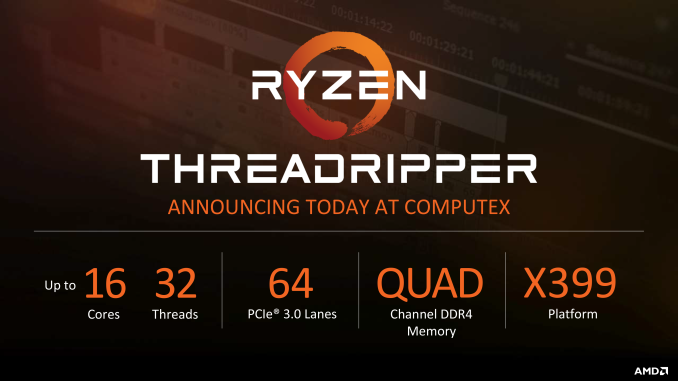
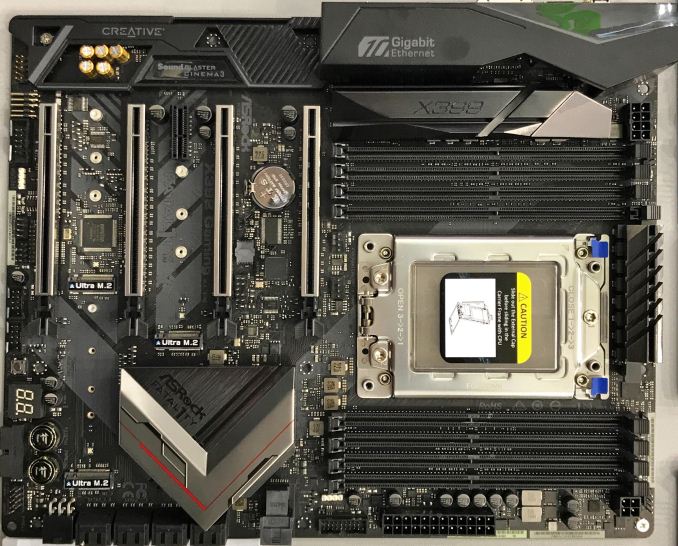
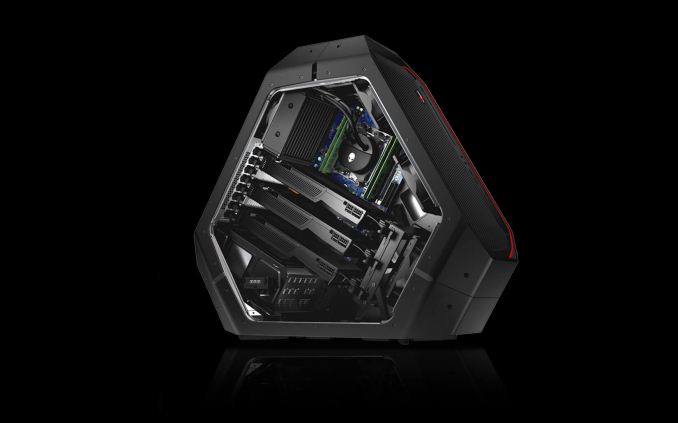
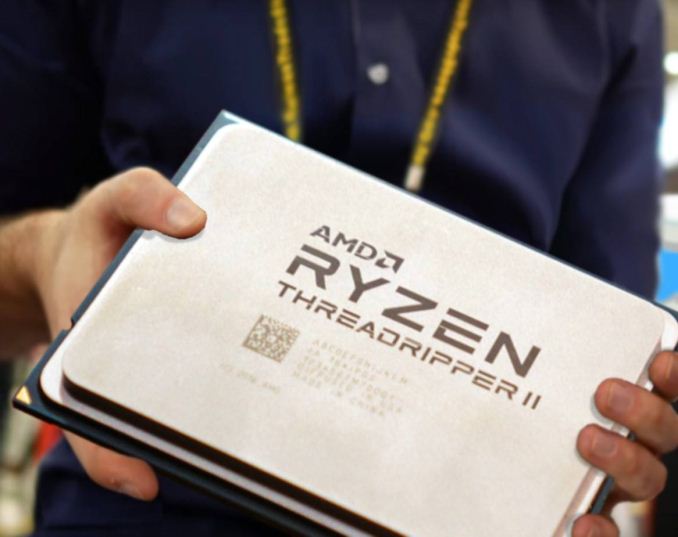








223 Comments
View All Comments
Chaotic42 - Friday, July 14, 2017 - link
Shut up and rip my threads, AMD. $$$Morawka - Saturday, July 15, 2017 - link
AMD is smart. They priced it high enough to prevent Intel from slashing their prices. Because AMD knows that most gamers will buy the intel chip if it's half way close to the AMD in cores and performance. AMD is giving a solid 40% discount here, you just have to deal with a inferior chipset.TheinsanegamerN - Monday, July 17, 2017 - link
That "superior" one requires a several hundred dollar USB key just to work properly.glugglug - Saturday, July 15, 2017 - link
The 1TB of RAM support is interesting...In particular, this is already requires 40 address bits, before getting into virtual, rather than physical memory.
The original AMD64 specification had the MMU set up such that any address where the upper 16 bits aren't all the same would be an automatic page fault. So basically in every 64-bit OS, 0xFFFF000000000000-0xFFFFFFFFFFFFFFFF is the kernel space, and 0x0000000000000000-0x0000FFFFFFFFFFF is user space, with anything else being invalid -- effectively only 48-bit addressing (256TB virtual address space) is possible.
Will this be changing in the next 5-10 years, with multi-socket servers starting to approach this limit?
msroadkill612 - Monday, July 17, 2017 - link
Vega is specced as having 512TB of address space, if that helps or is relevant.Given vega is also Fabric, I suspect ~epyc may also have a 512TB limit.
none12345 - Saturday, July 15, 2017 - link
"The original AMD64 specification had the MMU set up such that any address where the upper 16 bits aren't all the same would be an automatic page fault. So basically in every 64-bit OS, 0xFFFF000000000000-0xFFFFFFFFFFFFFFFF is the kernel space, and 0x0000000000000000-0x0000FFFFFFFFFFF is user space, with anything else being invalid -- effectively only 48-bit addressing (256TB virtual address space) is possible."When they did the amd64 spec, there was no point in putting all 64 memory address lines in hardware. You couldnt buy 16 exabytes of memory, so putting in the extra transistors in hardware to handle it would have been a waste of die space. So, they choose to just implement 48 bits of space, and hardwire the upper 16 to 1s.
This is a normal thing to do. Intel did it in the x86 spec as well. The first 32 bit processors did not support 32 bits in hardware for memory. I think they started with 24, but i cant remember. And the upper 8 bits left over were just set to 1s. Later on they implemented the additonal hardware to support the rest of the bits. AMD just extended that practice with the AMD64 x86 extension.
Any address >48 bits is a fault, because there is no hardware to connect more then 48 bits worth. The same is true of intel chips. Except i think they only do 40 or 44 bits currently, not 48. This may have changed with skylake or kabylake. Its been awhile since i looked up these metrics, but it was definitly less then 48 on intels implementation of amd64 when they first started to adopt it.
This is fine because you cant buy that much memory anyway. Remember this is a physical ram limit not a virtual ram limit. However there will also be virtual limits, because it makes no sense to allocate a page table for the entire 64 bit address space, when you cant use that much. All you do is slow down page look ups, and waste ram doing it.
These limits should be pretty easy to increase. For hardware you just add in the missing bitlines, and change the fault bit mask to check less bits. I think its likely they go to 56 bits next, not the full 64. Tho they could do 52 bits next, which covers 4 petabytes. Increses are already in the spec, i believe(its been many years since i looked at it, but i seem to remember it)
Right now most you can do anyway is 2 terabytes on epyc, so only 41 bits necessary, still got a ways to go before an increase in hardware is necessary. Probably good till 2025-2030 for servers, and for desktop were good for.....i duno mabye 2040.
Freebyrd26 - Saturday, July 15, 2017 - link
Skynet will go "live" before we reach that limit... ;)none12345 - Saturday, July 15, 2017 - link
"Ryzen is ok if u dont want raid nvme - u can have 2 x nvme using onboard x370 m.2 ports, but one is fast and the other, very fast."Err, you realize that raid nvme makes no sense on intel right?. The m.2 nvme slots are connected to the chipset. The chipset has a the equivilent of 4x pci3.0 lanes of bandwidth to the cpu. And thats shared by everything connected to the chipset. Sata, usb, sound, network, everythign else shares it. A single nvme drive can saturate a 4x link. If you try to do a raid 0 with 2 nvme drives, you would effectivly slow each drive down to 2x speed when you used them. There isnt enough bandwidth to do raid nvme. I meant you can do it, just dont expect the speed increase you would normally get from raid.
I do not know if any of the x299 boards have connected 2 m.2 nvme slots directly to the cpu. There are enough pci lanes on skylake-x to do it. But for compatability reasons, because they have to support 16 28 and 44 configs, they will likely connect all the m.2 slots to the chipset. Since there isnt enough room to do it on the kabylake-x version.
2 nvme on ryzen vs kabylake. On ryzen, you have 1 direct connected to the cpu at a full 4x link that it does not share. The 2nd one is connected to the chipset, likely at 4x 2.0 speed(2x 3.0 equivilent), or half speed. On kabylake you have 2 drives connected to the chipset, electrically 4x pci 3.0, but they have to share the equivilent of 4x pci 3.0 lanes to the cpu.
For ryzen, that means you can access 1 drive at full speed, and 1 at half speed(or a bit more depends on the drive). But you get that speed full time, regardless if you access 1 drive or both drives at the same time.
For kabylake, that means you can access either drive at full speed by themselves, but if you try to do both at the same time, both are half speed, since they have to share the single 4x link to the cpu.
This assumes you also arent maxing out USB ports at the same time. If you do that on kabylake, they also share the 4x link to the cpu, which means it will slow down either drive if used at the same time. If you do this on ryzen, some of the usb ports have their own link to the cpu, so if you used those it wouldnt slow either drive down. Other ports are on the chipset, and would share with the 2nd drive. However the chipset link is 4x and the 2nd drive is likely at 2x, so there is plenty of bandwith to do a lot of usb at the same time as well, before you start slowing down the 2nd drive.
In most workloads you wouldnt notice a difference between either platform tho. Normally you dont use everyting flat out at the same time.
msroadkill612 - Monday, July 17, 2017 - link
Yes, I was aware of intels chipset deviousness, but thanks for documenting this amazingly neglected intel gotcha - oh, & btw, u can only use ~one device at a time. Its like a house only allowing use of one water tap at a time.I was simply saying that your best option w/ ryzen w/ a 16 lane gpu & my recommended 2x nvme m.2 ports onboard the mobo, and its not a bad option. - A single nvme 3x best sata ssd speed, and a single nvme, 5-7x best sata ssd speed.
Intels chipset ports, as u describe, certainly preclude raid0 pcie3 nvme. To use a top ssd as it should be used, on the intel onboard m.2 port, would max out the entire chipsetS 4 lane bandwidth.
Yet they claim u can connect 2 such devices.
A notable rule of thumb w/ intel is, it is only $1k+ cpuS that offer 40+ pcie3 lanes. Some only offer 16 lanes - the scoundrels - what a dead end PC?.
I would be interested in your take on the intel non chipset architecture also. It seems suspiciously similar, using; cumbersome (multi hop data path / vs amd) switches and crossbars on the cpu io lanes - sharing limited bandwidth among many ports?
I cant believe its legal to tell such ~lies (even in the pinko EU it seems) as intel do with their 4 lane chipset - seeming to promise an endlessly expandable PC to newbs.
Outlander_04 - Saturday, July 15, 2017 - link
Ok. Great.16 cores and 32 threads.
Not worth anything for gamers, so who is the target audience for threadripper?
Encoders? Renderers? People who feel inadequate?